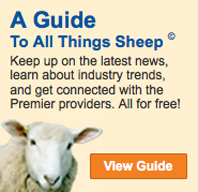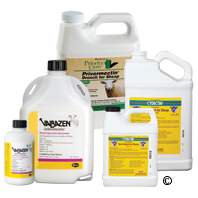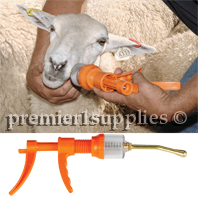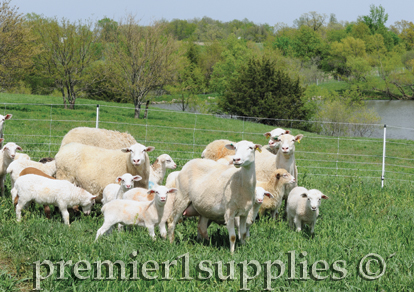
DEWORMERS
 Cydectin Sheep Drench
Cydectin Sheep Drench
For use in healthy sheep to control 13 types of adult and larval stages of internal parasites.
Valbazen
A broad-spectrum dewormer for sheep, cattle and goats.
Privermectin
For the treatment and control of adult fourth-stage larvae in sheep.
See all of our Drenching & Vaccinating products.
NEW! PRODUCT
 Manual Drencher
Manual Drencher
For dosing high volumes of fluid such as “show shakes” or other treatments. Best suited for folks with larger hands.
Folks like this unit for its high capacity and ability to be filled with one hand. To fill, depress the plunger, insert the drench bit into the desired liquid and remove pressure from the plunger. The unit is now ready for drenching.
PREMIER TIP
Parasite control for individual animals
During this time of the year internal parasites can be a major problem for many producers. Even if you have recently drenched your animals, you may still see signs of parasites. This could be from these animals somehow missing treatment, or they may have spit out the drench.
In any case, it's a good idea to have a small flock drencher on hand to treat those animals that slip through and need a second treatment. The small flock drencher has an adjusting nut that allows you to be more accurate with dosing each animal.
Gordon Shelangoski, Premier Product Consultant
Click here to see all of Premier's drenchers.
|
 |
 |

Use portable fencing (such as the Sheep QuikFence™ shown) to efficiently manage pastures for grazing. Rotating pastures aids in reducing the exposure of sheep to gastrointestinal parasites.
Cleaner pastures = healthier sheep
It's the time of year when shepherds begin keeping a keen eye on the jaws and eyelids of their stock. Worms are in abundance, and if sheep are on the same piece of ground for too long, worm loads may be high. Our shepherds are looking for the telltale swelling of bottle jaw. When lambs are weaned, we check the eyelids of suspect ewes for paleness (anemia). It takes time and work, but sheep can be healthier and pastures cleaner by keeping ahead of parasites.
The articles below provide useful information for managing parasites and using dewormers effectively. We particularly recommend taking the time and effort to study the Ohio State support tool. It's very good.
|
PARASITE CONTROL
Sorting through the information on sheep and goat parasite control: A decision-making support tool
By Ohio State University, College of Veterinary Medicine, Veterinary Extension
This decision-making support tool is designed to help sheep and goat producers sort through the large amount of information available on controlling sheep and goat parasites and make decisions about specific management options that are relevant to their farm operation. It is not intended to be prescriptive or replace your veterinarian with regard to diagnosis of parasitism or specifics of drug use.
We believe parasite control programs should be developed at the farm level. The information has been organized in a "decision tree" or "flow chart" approach where answering one question leads to another question or various management options.
Read More »
|
PREMIER HOW-TO
Controlling internal parasites in sheep & goats
It's been said that "the worst enemy of a sheep/goat is another sheep/goat." The primary reason is internal parasites. Worms cannot be eliminated, but they can be controlled with these management tools:
| 1. |
Graze the lambs/kids (and their mothers) on grass that was not grazed by sheep or goats in the spring of the preceding year. Examples are hay/silage fields, cattle or horse pastures, and cropland newly sown to grass. If you can do this (most cannot), then you only need to deworm the ewes/does once before they go out to grass.
|
| 2. |
Dewormers. Deworm the does/ewes just before they go out to grass. If they are grazing "dirty" pastures (had sheep/goats on it last year), continue to deworm them every 19–21 days (not 22) for the first 60 days of grass. Deworm the lambs and kids as soon as they are seriously grazing grass (about 5 weeks old). Remember that goats need twice the dosage rate of dewormer per lb of body weight that sheep do. Continue to deworm the lambs/kids until they can be moved to "clean" feed (feedlot, hay field, etc.) or until they are 120 days old.
|
| 3. |
Feed the ewes and does with high protein feed (e.g. soybean meal) prior to lambing/kidding. Experimental evidence suggests that doing so reduces the quantity of worm eggs that will be shed by lactating ewes and does on grass. Reducing the number of worm eggs shed is key to reducing the damage that they do—which is also why 21 days (as noted in item 2 above) is critical. It takes 21 days for a larva that's been consumed by a sheep or goat to begin producing worm eggs.
|
| 4. |
Reduce the stocking rate by grazing cattle or horses with sheep/goats. The internal parasites of the first two species don't affect the last two species—but sheep parasites do damage goats and vice versa.
|
| 5. |
Don't graze the grass too short. A worm larvae that hatches from eggs deposited on the ground in sheep/goat manure can only climb about 4 inches up a grass blade. So forage taller than 4 inches is relatively free of worm larvae.
|
| 6. |
Do periodic testing of fecal samples. The results allow you to determine if a dewormer is necessary and which parasites need to be treated.
|
Read More » Collecting fecal samples.
See Premier's Livestock Treatments.
|
PARASITE PREVENTION
Parasite prevention
By Micky Burch
Parasites are largely thought of as a limiting factor in sheep production, especially on pasture. According to the SID Sheep Production Handbook, larval development on pasture and the subsequent ingestion of the infective larval by sheep is affected by many factors, especially temperature and moisture.
Because sheep are managed under various conditions, regional differences occur in the development of parasites, and subsequent prevention and control strategies used. Producers should have a good working knowledge of parasite biology and how these regional differences affect the development of disease in order to design a practical and effective control strategy.
Within regions, many shepherds specialize their flocks, concentrating on things like dairy production, organic meat and wool production or raising show sheep. Like regional differences, specialty sheep production also requires a unique understanding of parasite prevention and control.
Organic flocks
Snoqualmie Valley Lamb® is a 100% grass-fed, U.S. Department of Agriculture-certified organic program that produces lamb at Aspen Hollow Sheep Station. Sustainably managed on 65 acres on the banks of the Snoqualmie River near Duvall, Wash., Aspen Hollow lambs spend their entire life on grass and in clover fields.
Read More »
|
|